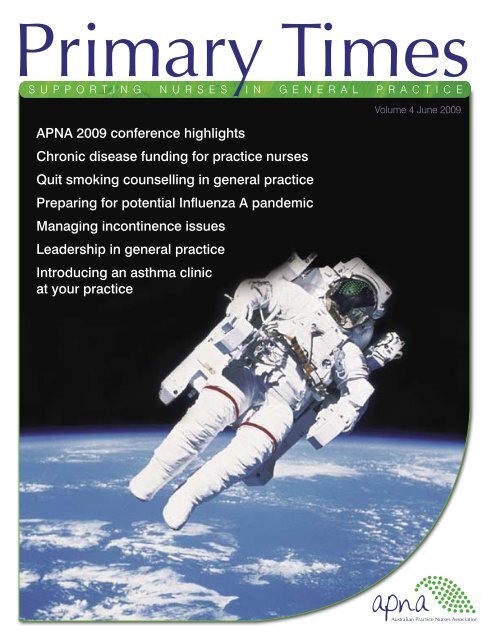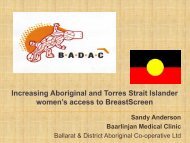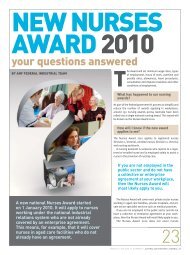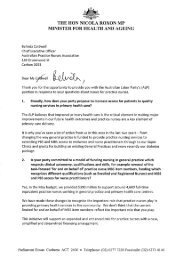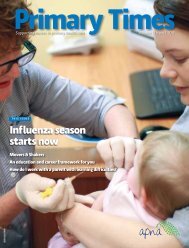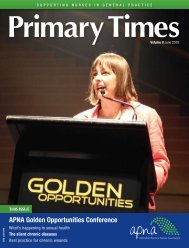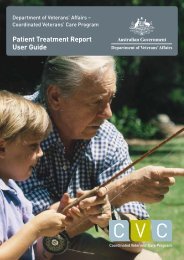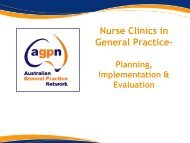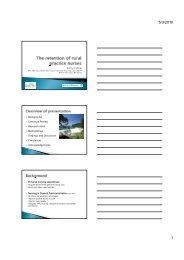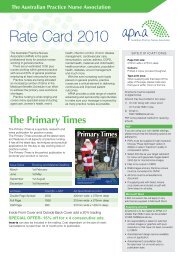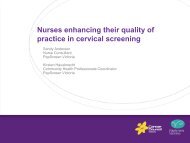June - APNA
June - APNA
June - APNA
- No tags were found...
Create successful ePaper yourself
Turn your PDF publications into a flip-book with our unique Google optimized e-Paper software.
<strong>APNA</strong> 2009 CONFERENCE‘The Conference has been great. It has beeninformative with good networking opportunities.The presentations have been relevant to thechanging times in general practice. Well worthcoming to! I will be taking a good deal ofinformation from the presentations and industrydisplays back to my practice to utilise.’Maggie Chown, from the Rose Street Clinic, SA.FRIDAY’S EVENTSThursday’s Opening Ceremony was somagnificent and everyone was left soinspired that I was afraid that Friday wouldnot live up to it. However, we were treatedto a wonderful array of knowledgeablespeakers, on a diverse range of topics,from across the country.The morning started with RosemaryBryant providing the vision for PNs in2020. This followed by a panel discussionabout the advanced nursing roles ingeneral practice, including where the roleis headed, what is hindering or enhancingits progress, and the models of care.The sessions covered: managing a diverserange of chronic diseases; women’s healthand sexual health; physical activity for theelderly; clinical leadership; and writing fordifferent audiences.Following lunch, ‘Laughing Matters’entertained us with a delightful spoof of thevery serious subject of instigating change.The hypothetical, set in the township‘Toobusybusy’, was very thought provoking.The afternoon continued with sessionson chronic diseases, systems for health,measuring what you do, open spacediscussion, and learning to move for ahealthy heart. And, then it was night time:And just once in a blue moonIn a beautifully decorated roomRobbie Williams made us swoon.While we ate delicious food,The wine put us in the moodAnd the DJ was such a dude.We twisted and bopped,We danced till we droppedOr our kneecaps popped,And oh! What a wonderful time!What a magnificent conference thishas beenAnd hey! It hasn’t finished yet!Jenny DandeauxCSL exhibition stand.One of the many in-session discussion.Cheque presentation to the Otis Foundation.The entertaining ‘Robbie Williams’ act.‘Once in a Blue Moon.’<strong>APNA</strong> Primary Times <strong>June</strong> 2009 5
<strong>APNA</strong> 2009 CONFERENCE<strong>APNA</strong> conference abstracts<strong>APNA</strong> is pleased to showcase five of the 32 high quality abstracts presented at the‘The Right Stuff’ <strong>APNA</strong> Visionary Conference 2009 in this edition of Primary Times.ABSTRACT:FUTURE DIRECTIONS IN THE USE OF SILVER IN BACTERIAL BURDENED WOUNDSPindara Medical Centre on the GoldCoast has been known for its excellencein treating chronic wounds. Recently thepractice (one of 10 practices throughoutAustralia) was asked to undertake a trialto evaluate two new products yet to bereleased to the Australian market. Bothproducts were a hydrocellular foamcontaining silver sulphadiazine.Patient permission was gained for the trialand dressing material was provided at nocost to the patient. Wounds were a mixtureof chronic venous wounds, skin tears, andone burn case. The wounds were chosendue to clinical signs of increasing bacterialburden dependent on the wound type, anddressing changes were either attendedtwice weekly or weekly. Evaluation includedpatient comfort, ease of removal, ease ofapplication, conformability, fluid handling,protection of peri-wound skin, overallperformance and reduction of odour.Adhesive and waterproof products werealso evaluated.This small trial is presently ongoing and hasseen some pleasing results in the treatmentof critically colonised wounds. A particularstand out has been patient comfortbecause of conformability, ease of removal,and being able to return once instead oftwice for weekly dressing changes. Anotherbenefit for some patients has been the useof the adhesive waterproof product.There has been a noticeable declinein the use of Acticoat (nanocrystallinesilver), where management of exudaterequired the use of multiple layers ofdressing, increasing patient discomfort,and dressing costs.The use of silver products in bacterialburdened wounds reduces the needto use costly systemic antibiotics andassociated multi-resistance problems.Nursing staff are now more aware of theimportance in the recognition of bacterialburden in chronic exudating wounds andare able to recognise which wounds wouldbenefit with the use of the new products.AUTHOR:Susan HalseyABSTRACT:THE RETENTION OF RURAL PRACTICE NURSESReflexive identification and explorationof issues affecting the retention ofrural practice nurses is of particularimportance to the rural health setting.New practice nurses have been recruitedwith support from the AustralianGovernment Department of Health andAgeing as a strategy to address thegeneral healthcare workforce shortages,particularly in rural under serviced areas.The practice nurse workforce is ageing,and this has implications for retention ofmany rural practice nurses, particularlyas they consider retirement.A literature review identified that currentresearch on rural practice nurse retentionis scant. This setting is unique andunfamiliar to most researchers, whencompared to research on general hospitaland community nurses. The rural practicenurse population is small and rarelyconsidered as a professional nursingcareer option. This unique healthcare areadesperately needs greater recognition inorder to meet the needs of the grosslyunderserviced rural communities asidentified by government policy makers.This small qualitative study examined thesocial and professional issues related torural practice nurses, on the NSW SouthCoast. Data has been gathered frominterviews exploring what attracted thesenurses, what keeps them working ingeneral practice or if they intend to leave.Interviews commenced in November2008 and will be conducted until datasaturation is reached.Tentative emerging professional andsocial issues include scope of practice,time restraints and complexity of clienthealth problems, loss of anonymityand family commitments. These arebeing explored in relation to motivation/discouragement to enter practice nursingand motivation/discouragement to exitpractice nursing.Policy makers currently can onlyimagine what issues may affect ruralpractice nurses. When we understandexactly what is experienced by thosein this unique role and setting, effectiveretention strategies can be planned.AUTHORS:Kathy GodwinAssoc. Prof. Janette CurtisYvonne White6<strong>APNA</strong> Primary Times <strong>June</strong> 2009
<strong>APNA</strong> 2009 CONFERENCEABSTRACT:WHAT DO PATIENT ENCOUNTERS WITH PRACTICE NURSES LOOK LIKE? A NATIONAL STUDY OF5268 ENCOUNTERS.There is a significant gap in knowledgeabout what general practice nurses(GPNs) do in their interactions withpatients. Existing data sources such asMedicare statistics and the ‘BEACH’studies are focused on generalpractitioners (GPs) and provide minimaldata about GPNs’ clinical work. The aimof this study was to describe nurse-patientencounters in Australian general practice.Data was collected on 5268 patientencounters by 104 GPNs from locationsacross Australia. The study used avolunteer sample of registered andenrolled nurses working in generalpractice, who each collected informationabout 50 consecutive contacts withpatients using an ‘encounter form’modelled on those used in the BEACHstudies. Data was collected betweenMay 2007 and May 2008.Nurses in the study sample had asimilar profile to known characteristicsof the Australian GPN population. Themajority of GPN-patient encounters wereconducted at the practice (93%) andface-to-face (93%). Almost two-thirds ofpatients (63%) had an appointment withthe nurse for their consultation. A rebatefor one of the eight GPN Medicare itemswas claimable for 42% of encounters.A GP saw the patient immediatelyprior to the patient seeing the nurse forabout one-third of encounters (35%),and immediately afterwards for 44%of encounters. A GP was present forsome of the time during 34% of nursepatientencounters, all of the time for4% and none of the time for 62% ofencounters. Overall, a GP was involvedto some extent in 73% of nurse-patientencounters.Practice nurses interact with doctors in arange of ways during their daily work withpatients and commonly have their ownappointment system. Further analysis ofclinical conditions and patient profiles isforthcoming.AUTHORS:Catherine JoyceProf. Leon PitermanAlso read ‘The introduction of chronic disease funding for general practice nurses’ abstract on page 10 and the ‘Taking up quitcounselling in general practice’ abstract on page 12.LAUNCH SPECIAL$39.00Available to <strong>APNA</strong> MembersNew Practice Nurse WorkwearThese stylish, tailored shirts with 3⁄4 sleeves are available in green andchambray. Each shirt has the <strong>APNA</strong> logo and Practice Nurse clearlyembroidered to ensure you stand out at your practice. Available in sizes8, 10, 12, 14, 16 and 18 (larger sizes available on request).Call us on 03 9614 7777 for an order form today.<strong>APNA</strong> Primary Times <strong>June</strong> 2009 7
RESEARCH<strong>APNA</strong> commissions research toimprove membership<strong>APNA</strong> has grown, as has the roleof practice nurses (PNs), and nowencompasses around 1500 members.However, with approximately 8000 PNsin Australia, there remains a hugelyuntapped market for <strong>APNA</strong>.<strong>APNA</strong> commissioned Jigsaw StrategicHealthcare to conduct research earlierthis year. Jigsaw provides research andstrategic marketing advice, specialisingin healthcare, youth, and internationalmarkets.Jigsaw was tasked with ascertaining thedrivers and barriers to PNs joining theAssociation so that effective strategiescan be implemented to increasemembership.<strong>APNA</strong> also wanted to gauge currentperceptions and understanding of theAssociation, in terms of the benefits andofferings in its membership. Researchneeded to examine how PNs think,feel, and speak about <strong>APNA</strong> to captureexisting thoughts and attitudes towards it.Jigsaw conducted a series of qualitativemini groups in Sydney and Melbourne,amongst both member and non-membernurses. The research resulted in numerousinteresting findings pertinent to the project.‘We need lobbying because the profession is still in its infancy ...we need anorganisation to champion our cause ...we need to be unified to move forward.’Research found that nurses awarenessof <strong>APNA</strong> and the benefits it offers islower than their awareness of generalpractice divisions and union associations.The need to raise awareness of theAssociation and its key benefits isparticularly important amongst non-<strong>APNA</strong>members. This presents a need to raiseawareness of <strong>APNA</strong> and its key benefitsamongst PN rank and file.Another finding was that both youngerand older PNs see a strong future forthe profession. They believe that as GPsincreasingly understand the role that PNscan play in general practice, the numberof PNs will continue to rise. <strong>APNA</strong> canplay a major role in helping increase thestanding of the PN profession. It can alsohelp to educate GPs to understand the fullpotential value and contribution of PNs.Education was seen as one of thestrongest benefits offered by <strong>APNA</strong>.Online education is particularly attractiveto many PNs as it can be undertakenat times convenient to the nurse. Thereare, however, competing sources ofeducation. There are some perceptions8 <strong>APNA</strong> Primary Times <strong>June</strong> 2009
RESEARCHthat <strong>APNA</strong> education offerings are ratherad hoc, lacking accreditation and/or theability to build skills systematically acrosssuccessive courses. The research foundthat unless PNs are required to accrueCPD points each year, the <strong>APNA</strong> CPDeducation program is likely to have alimited appeal.Cost, time, and staff resourcing was seenas the main barriers preventing accessto the conference, particularly for nursesbased outside of Melbourne. It is hardfor many to take time off work and to getfunding support to attend a conference.The majority of nurses felt that lobbyingactivities are important for <strong>APNA</strong> in termsof reinforcing and growing the identityand role of the PN. ‘We need lobbyingbecause the profession is still in itsinfancy ...we need an organisation tochampion our cause ...we need to beunified to move forward.’The Primary Times magazine is liked bymembers and non members. The onlinenewsletter has appeal, provided it is keptshort and relevant and not issued toofrequently. Providing the hardcopy PrimaryTimes magazine to non members couldpotentially lead to increased membership.A greater awareness of the benefits of<strong>APNA</strong> professional indemnity insuranceis needed to improve the overall uptake.Research found that many nurses believethat their employer’s insurance coversthem. The cost of the insurance is also abarrier to uptake.Online discounts received a mixed response.In general, discounts on smaller everydayitems and work related items are the mostunique and attractive. Many are also unawarethat <strong>APNA</strong> offers discounts of any kind.Research found that the online careerssite is very appealing. However, fewnurses are aware of it. <strong>APNA</strong> needs tobuild awareness of this online resource.Cost is a major barrier to <strong>APNA</strong> membershipfor many PNs. Research suggests thata staggered membership payment system,such as quarterly direct debit payments, willmake membership more feasible for some.Jigsaw also explored a number of waysto attract new members. The recruitingmethods with most potential are:• Word of mouth via other PNs andhealthcare professionals.• The local Divisions of General Practice.• Brochures and other hard copymaterial either sent directly to nursesor provided at meetings and seminarsattended by PNs.‘Overall, increasing awareness of key <strong>APNA</strong> member benefits amongst nonmembers was seen as the key in arousing interest in the Association andincreasing membership.’Overall, increasing awareness of key<strong>APNA</strong> member benefits amongst nonmembers was seen as the key in arousinginterest in the Association and increasingmembership.For us at <strong>APNA</strong>, this very valuableresearch has provided us with strongguidance on where we need to focus ourscarce resources in the effort to attractand retain members. In many ways theresults were not surprising and we arefrequently presented with a vast array ofoptions on what we could do.It has been hard to pick a few key strategiesand stick to them. The key message for uswas that almost all non-<strong>APNA</strong> memberswere completely unaware of what <strong>APNA</strong>offered and were pleasantly surprised.An initial response has been to producea more clearer membership brochureoutlining <strong>APNA</strong> benefits and to distributethese through PNCEs and Divisions ofGeneral Practice. Copies will be madeavailable for members to hand out locallyand can be obtained by contacting MattHall on (03) 9614 7777 or email:matt.hall@apna.asn.au<strong>APNA</strong> Primary Times <strong>June</strong> 2009 9
<strong>APNA</strong> 2009 CONFERENCEThe introduction of chronic diseasefunding for general practice nursesCHRONIC DISEASE MANAGEMENTIN GENERAL PRACTICEChronic and complex conditions presenta major challenge to contemporary healthsystems and are responsible for high levelsof both individual and societal burden. Theseconditions are being increasingly managedin the community sector, particularly withinthe general practice setting.Although general practice has had alongstanding role in chronic diseasemanagement, workforce models andgovernment funding have historicallyimpaired service delivery. The complex andmultifaceted care required to appropriatelymanage chronic disease requires aninterdisciplinary approach.It has been demonstrated internationally thatboth care processes and health outcomescan be improved by using nurses and alliedhealth professionals to augment the role ofprimary care doctors. 1A national survey of practice nurses inAustralia identified that several significantbarriers existed to nurses adopting a greaterrole in chronic disease management. 2Barriers included the legal implications ofrole expansion, a lack of space, a belief thatthe current role is appropriate, and generalpractitioner attitudes. 2 Implicit in thesefindings was the lack of reimbursement forthe practice nurses role in chronic diseasemanagement by Medicare. 2In response to this growing evidence, arange of healthcare initiatives are beingundertaken in Australia to support generalpractice to provide better chronic care. 3,4These initiatives have included expansion ofthe practice nurse workforce, 5 changes ingeneral practice funding for service delivery, 6and funding for strategic research andevidence translation.PRACTICE NURSE MEDICAREITEM NUMBERSThe introduction of item numbers forpractice nurses in recent years has servedto define the role of the nurse. 7 While insome ways these item numbers haveconstraining the nurse’s role in generalpractice, the introduction of item numbershas also facilitated a broadening of thescope of the practice nurse role. To date,however, there has been limited evaluationof the impact of the funding of itemnumbers on the practice nurse role, patientsatisfaction, general practitioner workload,access to primary care, or health outcomes.There has been significant expansion inthe number and scope of item numbersavailable to practice nurses related to chronicdisease management in recent years. 6While some of these items are practicenurse specific, others include provisionfor a practice nurse to assist the generalpractitioner in various tasks. 6 Data on thenurse-only item numbers demonstratessignificant growth in the uptake of theseitems, particularly in the first quarter 2009. 8In those items where the nurse may ormay not assist the general practitioner, itis not possible from the available data todifferentiate whether or not a practice nursewas involved in providing the intervention.While the Medicare schedule broadly definesthe nature of activities within the scope ofeach item, to date there has been no attemptto evaluate the nature and scope of theinterventions provided by practice nurses.The BEACH data collection shows that in2007–2008 practice nurses were involvedin 5712 GP-patient encounters. 9 Thisrepresented 6% of all included encounters.Of these encounters with the practice nurse,only 2073 practice nurse item numbers wereclaimable. 9 Assuming that each encounterinvolved the claim of only one item number,only 36.3% of all encounters with the nurseattracted a Medicare benefit. At 65.3% ofthose encounters that were not claimable,the nurse performed a clinical or proceduralactivity. 9 Although this demonstrates thatinterventions provided under Medicareitem numbers represent a small proportionof the practice nurses current workload,understanding the nature of interventionsfor which item numbers are being claimedwill: (a) provide a baseline for developingfuture research related to practice nurse-ledchronic disease interventions in general10<strong>APNA</strong> Primary Times <strong>June</strong> 2009
<strong>APNA</strong> 2009 CONFERENCEpractice; and (b) identify strategies forpromoting the quality and consistency ofthese models of interventions. Despite theliterature describing the demographics ofpractice nurses in Australia, 7,10 the trainingand educational needs of practice nursesare poorly understood. Exploration of theseneeds is timely, given the rapid developmentof the chronic disease management roleand the imperatives to employ an evidencebasedapproach to service delivery.EVALUATION OF CHRONICDISEASE MANAGEMENT BYPRACTICE NURSESThe primary aim of this study is to evaluateinterventions provided under chronic diseaseMedicare item numbers by Australian generalpractice nurses. The specific objectives of theproject are to: (1) describe the nature and scopeof interventions provided by practice nursesunder the chronic disease item numbers;(2) assess practice nurses perceivedcompetence in providing chronic diseasemanagement and identify education/trainingneeds; (3) assess consumer perceptions ofpractice nurse-led chronic disease management;(4) evaluate general practitioner perceptions ofpractice nurse interventions provided under thechronic disease item numbers; and (5) identifythe barriers and facilitators to practice nurses’use of the chronic disease item numbers inAustralian general practice.To achieve these aims the researchers areseeking to recruit fifty registered nurses fromgeneral practices within New South Walesto complete a structured diary to detail theirpatient encounters related to chronic diseaseover ten working days. Patients who are seenby the nurse during this period will be invitedto complete an anonymous satisfaction toolor participate in a telephone interview abouttheir experience of receiving nursing care ingeneral practice. A general practitioner fromeach practice will be invited to participate ina telephone interview to examine the GPsperceptions of how the use of the chronicdisease item number contributes to clientcare and impacts on models of care withingeneral practice. Additionally, all practicenurses in NSW are invited to participatein a survey of practice nurses perceivedcompetence and education/training needsrelated to chronic disease management.CONCLUSIONThe current positive policy and fundingenvironment is fertile ground for thedevelopment of practice nurse services.However, the crisis of chronic care and theneed for an urgent response has limited thedegree of consultation in planning servicedelivery, evaluating care processes, andmeasuring the impact of health systeminnovations on clinical outcomes. Theselimitations make it timely to explore theimplementation of the chronic disease itemnumbers to inform further development ofthese interventions based on their feasibility andacceptability and impact on clinical outcomes.If your practice is located in NSW andyou would be interested in finding outmore about this project please contactDr Elizabeth Halcomb on 02 46203344or e.halcomb@uws.edu.au.AUTHORS:Elizabeth J. HalcombRN BN(Hons) Grad Cert ICPhD FRCNASenior Lecturer Schoolof Nursing & Midwifery,College of Health andScience, University ofWestern Sydney, Sydney Australia.Patricia M. DavidsonRN BA MED PhDProfessor ofCardiovascular andChronic CareCurtin Health InnovationResearch InstituteInstitute for Palliative and Supportive CareResearch AustraliaCurtin University of TechnologyREFERENCES:1. Katon W et al. Rethinking practitioner roles inchronic illness: The specialist, primary carephysician, and the practice nurse. General HospitalPsychiatry. 2001; 23(3):138–144.2. Halcomb EJ et al. Cardiovascular diseasemanagement: Time to advance the practice nurserole? Australian Health Review. 2008; 32(1): 44–55.3. Halcomb EJ et al. Nursing in Australian generalpractice: Directions and perspectives. AustralianHealth Review. 2005; 29(2): 156–166.4. Hall S. Divisions of general practice and practicenurse development in Australia. Advances inContemporary Nursing. 2007; 26(1): 37–47.5. Halcomb EJ. Nurses’ quiet revolution needs tomake some noise (Guest Editorial). AustralianDoctor, 2008. 25th April.6. Medicare Australia. MBS Online. 2008 [cited 2008October 10]; Available from: .7. Halcomb EJ et al. Nurses in Australian generalpractice: Implications for chronic diseasemanagement. Journal of Nursing and Healthcareof Chronic Illness, in association with Journal ofClinical Nursing. 2008; 17(5A): 6–15.8. Medicare Australia. Medicare Item Reports. 2008[cited 2008 October 8]; Available from:.9. Britt H et al. General practice activity in Australia2007–08. General practice series no. 22. 2008,Australian Institute of Health and Welfare: Canberra.10. Watts I et al. General practice nursing in Australia.2004, Royal Australian College of GeneralPractitioners and Royal College of Nursing,Australia: Canberra, ACT.<strong>APNA</strong> Primary Times <strong>June</strong> 2009 11
<strong>APNA</strong> 2009 CONFERENCETaking up quit counsellingin general practiceSmoking causes the deaths ofapproximately 17 000 Australians eachyear and is identified in the Smoking,Nutrition, Alcohol and Physical Activity(SNAP) framework as the behaviouralrisk factor associated with the greatestburden of disease on our population.While more than 80% of Australians visita general practitioner (GP) at least oncea year, most smokers will visit severaltimes. The general practice can thereforebe a great source of smoking cessationadvice. However, translating this potentialinto sustained activity has proved difficult.Advice for smoking cessation has notincreased despite the availability ofevidence-based guidelines and effectiveGP strategies.This lack of activity can be attributedto: perceived of lack of effect; lack ofGP time; lack of GP skills; reluctance toraise the issue due to patient sensitivityabout smoking; perceived lack of patientmotivation; and GPs not using effectivestrategies or using ineffective strategies.Another practical barrier is the ability toaccurately identify smokers in generalpractice. In Australia, evidence shows thatdoctors identify two-thirds of their patientswho smoke and advise only about half ofthese to quit.It is therefore important the role of healthprofessionals, in particular practice nurses(PN), in providing a primary care basedsmoking cessation service is developed,while not ignoring or deskilling GPs.A Cochrane Review of nursing interventionsfor smoking cessation found 20 of the 29studies meeting inclusion criteria provedthere was a significant benefit in nursingintervention compared to control or usualcare. There is, however, a lack of researchavailable in an Australian context of PNstaking on this important role.DEMONSTRATION PROJECT INNEW SOUTH WALESNurses in general practice in NSW haverisen to the challenge of a new role inproviding quit counselling and havesucceeded in getting results of which theycan be proud! The Demonstration Project,run by The University of New South Walesin collaboration with the Macarthur Divisionof General Practice (Campbelltown) andthe Southern Highlands Division of GeneralPractice (Bowral), was presented at TheRight Stuff <strong>APNA</strong> Conference held recentlyin Melbourne.The project involved 31 PNs, 35 GPs, and498 patients from 19 general practices.The PNs joined the project to test out thenew role of quit counselling in the generalpractice setting. The project followedpatients over a six-month period, whilethe nurses assessed cessation rates andvalidated patient self-report by using anexpired carbon monoxide monitor.The PNs received four hours of trainingfrom Prof. Robyn Richmond, Prof. NicholasZwar, and project co-ordinator RNGail Forlonge. This training, based onthe Smoking Cessation Guidelines forAustralian General Practice 2004, wasendorsed by the Royal College of NursingAustralia and added another skill to theCVs of these RNs. The training programcovered smoking cessation counselling,the role of pharmacotherapy with a focuson use of Nicotine Replacement Therapy(NRT), and project procedures.The nurses were also provided withsmoking cessation resources includingthe guidelines and a counselling checklistdesigned for each patient visit. The PNswere able to call Gail to ask questions, asthey found their footing in this new role.The PNs quickly mastered the role, withGail only needed to take an occasionalcall. She also conducted regular practicevisits to maintain contact and support.In the service model, GPs identifiedsmokers interested in quitting and referredthem to PNs for a series of 30-minuteweekly counselling visits over a four-weekperiod. The nurses offered Quitline referralfor further support during the quit attempt.Patients attending the visits could accessan eight-week course of nicotine patches12 <strong>APNA</strong> Primary Times <strong>June</strong> 2009
Clinically provento speed up thehealing processArginaid ® : a nutritional drink that uses l-arginine to promote wound healing.As the body needs more protein during wound healing the demand for normally nonessential amino acids,such as l-arginine, becomes essential. Dietary supplementation with l-arginine has been shown to enhanceprotein metabolism, helping to decrease muscle loss, and promote collagen synthesis, which helps to increasethe strength of the wound. 1-4 Not only is l-arginine essential for the stimulation of the nitric oxide pathway butsupplementation with l-arginine has been shown to enhance the immune system. 1-4Coming Soon: RCNA accredited Nutrition and Wound Care workshops with CNE points.Register your interest via 1800 671 628 or email Tenille.Larcombe@au.nestle.comArginaid ®1. Arana V. Biomed Pharmacother 2004. 2. Wallace E. Br J Nurs 1994. 3. Desneves KJ. Clin Nutr 2005. 4. Langemo D. Adv Skin Wound Care 2006. Nestlé Healthcare Nutrition, 20-24 Howleys Road,Notting Hill VIC 3168, Australia. 1800 671 628 (toll free) www.nestlenurition.com.au ®Reg. Trademark of Société des Produits Nestlé S.A. NHNCN2327
NEWSImprove your knowledge of eye healthonline assessment to ensure the mainlearning objectives have been met.The Vision Initiative is a public eyehealth program that aims to preventavoidable blindness and reducethe impact of severe vision loss.Implemented in Victoria as a pilotproject by the Vision 2020 Australiapartnership, this initiative raisesawareness of the importance of eyehealth among the general public,health and community sectors, andgovernment.In working with member organisations toincrease awareness of eye health issues,the Vision Initiative team is excited topresent to <strong>APNA</strong> members the onlinelearning module ‘An introduction to eyes’.The program aims to provide PNs withan understanding of the anatomy andfunction of the eye, the five main eyeconditions, and an introduction to eyehealth and vision care. There is a briefPractice nurses will use the knowledgegained through this education sessionto improve the quality of nursing careprovided to all clients by raising theirknowledge and skills in relation to eyecare. Completion of the course willprovide two CPD points.For more information please contactthe Vision Initiative team at Vision2020 Australia on 03 9656 2026.SIMONE CARREPUBLIC SERVANT3 WEEKS LEFTTO ENSURE YOURPATIENTS HAVETHEIR FREE CERVICALCANCER VACCINEBEFORE 30 TH JUNEHURRY.COMMENCEBEFORE30 TH JUNE.The Government funded HPV catch-up program is about to end. To be eligiblefor the free vaccine, females 18-26 years must commence their course before30th <strong>June</strong> and complete all 3 doses by 31st December 2009 1 .18 REFERENCES <strong>APNA</strong> 1. Primary Department Times of <strong>June</strong> Health 2009 and Ageing 2007 National Human Papillomavirus (HPV) Vaccination ProgramImmunisation Provider Guidelines & Summary for General Practice. Trademark of CSL Biotherapies, Parkville Vic 3052.
Wife carryingFinlandEveryone’s idea of fun isdifferent; for some it’s wifecarrying. Originating inFinland but now populararound the world, the raceinvolves male contestantscarrying their wives arounda set course. So, whateverpeople choose to do, it’sgood to know there are nolimits to having a good time.Whatever each day holds,don’t let asthmahold them backYour patients can achieve more with a goodasthma management plan – considerPBS Information – Restricted Benefit: Asthma: Patients who previously had frequent episodes of asthma while receivingtreatment with oral corticosteroids or optimal doses of inhaled corticosteroids and who have been stabilised on concomitantinhaled salmeterol xinafoate and fluticasone propionate.GSR5170_PC0811114_PT_July09Seretide (fluticasone propionate/salmeterol xinafoate) Accuhaler & MDI Minimum Product Information. PLEASE REVIEW FULL PRODUCT INFORMATIONBEFORE PRESCRIBING: Indications: Regular treatment of asthma where the use of a combination product is appropriate. This may include: patients on effectivemaintenance doses of long-acting ß 2 -agonists and inhaled corticosteroids, patients who are symptomatic on current inhaled corticosteroid therapy, * initiation ofmaintenance therapy in patients with moderate persistent asthma not adequately controlled on “as needed” reliever medication, and who have moderate/severeairway limitation and daily symptoms requiring reliever medication every day. For the symptomatic treatment of patients with severe COPD (FEV 1 12 years: 2 inhalations BD (Seretide MDI 50/25 or Seretide MDI 125/25 or Seretide MDI 250/25); children4 years: 2 inhalations BD (Seretide MDI 50/25). COPD: Adults: 2 inhalations BD (Seretide MDI 250/25) OR 2 inhalations BD (Seretide 125/25) in patients atgreater risk of inhaled corticosteroid adverse effects. Accuhaler: Asthma: Adults & children >12 years: 1 inhalation BD (Seretide 100/50 Accuhaler or Seretide250/50 Accuhaler or Seretide 500/50 Accuhaler); Children 4 years: 1 inhalation BD (Seretide 100/50 Accuhaler). COPD: Adults: 1 inhalation BD (Seretide500/50 Accuhaler) OR 1 inhalation BD (Seretide 250/50 Accuhaler) in patients at greater risk of inhaled corticosteroid adverse effects. The recommended dose forinitiation of maintenance therapy in moderate persistent asthma is 100/50 micrograms fl uticasone propionate/salmeterol twice daily. *Please note: these arechanges of clinical signifi cance to the PI. PBS listed prices: Seretide MDI: 50/25 $46.77, 125/25 $58.88, 250/25 $78.24; Seretide Accuhaler:100/50 $46.77, 250/50$58.88, 500/50 $78.24. For full Product Information please contact GlaxoSmithKline Australia Pty Ltd. 1061 Mountain Highway, Boronia, Victoria,3155. ABN 47 100 162 481. ®Seretide and Accuhaler are registered trade marks of the GlaxoSmithKline group of companies PC0811114.
BEST PRACTICE AWARDLeone Dunn2008 Best Practice Award Winnerdietitian and how to read those labels;falls awareness and suitable footwearand foot care. These evenings continueto be popular.I have been able to achieve all this throughcommitment to further education andongoing professional development, whichhas made my role even more rewarding.This year I am embarking on the GraduateCertificate Nursing (General Practice)Course at Sunshine Coast University.Leone Dunn from Gymea Medical Practicewas awarded the 2008 Servier Best PracticeAward for Innovation and Commitment toNursing in General Practice. Leone identifiedthat many elderly residents were lonely andsocially isolated and many failed to regularlyexercise due to their various fears.In recognising the importance of exercise inmaintaining health, particularly for thosewith osteoporosis and heart disease, Leoneinstigated patient education evenings.Leone talks about this and various otherinitiatives at her practice...I have been a practice nurse for manyyears. I work in a suburban practice in theSutherland Shire of NSW, with five doctorsand another nurse. We recently moved toa purpose-built facility, which allowed meto really utilise my skills. The extra spaceprovided me with the opportunity to set upmany initiatives:• Diabetic clinic. Allowing for betteroutcomes for patients. Patients arereviewed three-monthly. Each patienthas a personalised clinic bookdisplaying results and when they aredue for follow up tests. Referrals andthe GP Management Plan (GPMP) arealso kept in this book. We now havea dietitian and podiatrist consulting atthe surgery, enabling easy referral andaccess to these services.• Walking club. While doing healthassessments and GPMPs, I found therewas an increasing need for patients toexercise and to socialise. Patients withdiabetes, and those overweight or justlonely, were all invited to come along.We walk twice weekly at lunchtime, andhave lunch at a local restaurant or abarbeque at the surgery once a month.The doctors are very supportive andencourage patients to participate.• Relay for Life. This year our surgery staffand patients entered a team in the localevent to raise money for Cancer Council.Everyone has accepted this event withenthusiasm. (I will be going from theairport straight to the track, after the <strong>APNA</strong>conference in Melbourne.)• Knitting club. Patients knit squares for‘Wrap for Love’, sponsored by the ABC.We made five rugs last year, and I havealready sewn 17 rugs so far this year. Weoften have afternoon tea on a Saturdaywhen our knitters come together fora chat, knit, and cuppa. This is also agreat activity for patients experiencinglong waits to see the doctor.• Patient education evenings. With thesupport of various drug companies,we have been facilitating educationevenings, including: diabetes education;exercise with an exercise physiologist;Through scholarships, I have been ableto complete both the Immunisation andWomen’s Health courses. This has ledto a role with NSW Health where I runschool vaccination clinics and also assista male solo GP with a three-monthly Papsmear clinic. It is incredibly rewarding toknow my commitment to professionaldevelopment has allowed me to helpwomen and children in an isolated area.I have also attended many courseson diabetes, including Diabetes in theGeneral Care Setting, Advanced DiabeticCare, and Foot Care.My other passion is wound care. I am amember of the Wound Care Associationof NSW (WCANSW) and regularly attendtheir conferences and seminars. I am alsoa member of <strong>APNA</strong>, and attend the PNCEin Sydney each year, the Royal College ofNursing, and the Nurse Reference Groupin the local Division of General Practice. Ialso mentor new nurses for the Division.I gain tremendous satisfaction as a PN, asI am able to contribute in some way eachday in making someone smile. It gives mean enormous sense of pride to know mywork impacts directly on the health andwellbeing of the people who come to ourpractice. I encourage all nurses with apassion (or just a little idea) to go for it.It can be very rewarding!<strong>APNA</strong> Primary Times <strong>June</strong> 2009 21
PRACTICE NURSE PROFILEManaging incontinence issuesin general practiceMy role as the Chronic Disease ManagementNurse at Stellar Medical Centre in Lowood,Queensland, allowed me to identifyproblems that patients often consideredtoo embarrassing or taboo to discuss.The problem of urinary and faecalincontinence has become more prevalentin our ageing population, and thus seriouslyinfluences the physical, psychological, andsocial wellbeing of affected individuals.I trained initially as a Continence Adviserat the Australian Catholic University inMitchelton, Brisbane, in 2002. Blue Care,an organisation providing communityhealth and aged care services inQueensland, worked in collaboration withthe University to develop the ContinenceAdviser course. (There are more simplifiedcourses now available around Australia–many can be found on the ContinenceFoundation of Australia website:www.continence.org.au.)I have a special interest in caring forthose affected by incontinence and keepupdated with best practice assessmentand treatments. In collaboration withour practice principal, I developed andutilise a helpful Continence AssessmentTool, which is included in our PracticeProcedure Manual for reference.Through our quality meetings each month,we discussed how the continence toolwas progressing and made any necessarymodifications as they arose. The Plan-Do-Study-Act (PDSA) System was utilisedfor any issue requiring discussion. Thereweren’t many changes necessary. The trialwas on both men and women.The Continence Assessment Tool includesquestions to ask the patient regarding:duration of condition, BMI, blood pressure,medical/surgical/obstetric history; currentmedications; identification of type ofincontinence, e.g. stress/urge/retentionor overflow/reflex/nocturnal enuresis/Continence Advisor Lyn Field (right) with a patient, Elizabeth Stephens.functional; manual dexterity; cognitiveimpairment; environmental issues; dietand fluid intake; bowel habits; andurinalysis. Previous management is alsodiscussed and is very important for futureplanning.The Continence Assessment Tool alsoincludes Management Action PlanStrategies and Outcomes, such as: pelvicfloor muscle exercises; increase/maintainfluid intake 1.5–2 litres/day; elimination ofbladder irritants, e.g. tea, coffee; bladdertraining—defer the urge techniques;suggest commencement of oestrogencream per vagina; double voiding;dietary advice; bowel management;pear juice; cranberry capsules; toiletposition;positive thinking; trial of aidstypeordered; brochures issued; reviewappointments made; significant other.A collaborative multidisciplinary approachto continence management over the pasttwo years in our practice has borne verypositive outcomes for many of our patients.The GPs and PNs in our practice arefamiliar with the tool, and find it very useful.22<strong>APNA</strong> Primary Times <strong>June</strong> 2009
PRACTICE NURSE PROFILEHealth Assessments and GP ManagementPlans provide opportunities to identify ifpatients have an incontinence issue. A fullcontinence assessment—which takesabout 20–30 minutes—is then offered tothe patient, as a separate appointment.If the patient has had a GPMP/TCAcompleted, and also presents with aco-morbid disease such as diabetes,osteoarthritis etc., the Medicare Itemnumber 10997 can be charged bya PN for the provision of education,monitoring, and support for chronicdisease management as well as theGP consult. Working collaboratively, theGP and PN are able to trial strategiesfor improvement, refer patients to aphysiotherapist if required, and thenfollow through with a review visit.Many useful resources are available freethrough the Continence Foundation ofAustralia. Brochures on pelvic exercisesfor men and women, bladder training,good bladder habits, prolapse, andexcellent children’s resources arenow available. I use these as a walldisplay, and distribute according to thepatients needs and issues identified onassessment. I participate in ContinenceAwareness Week (2–8 August 2009)activities, and help organise and promotecontinence issues wherever possible.I keep abreast of current trends andchanges in continence care by being amember of the Australian Continencefor Nurses Foundation and attend theNational Continence Conference whenpossible, which is to be held next inAdelaide, 4–7 November 2009.I have a great sense of pride andachievement that what we are doing atStellar Medical appears to be improvingand making a difference in the lives of ourpatients. It was a great pleasure to havemy efforts recognised by my practicecolleagues by being nominated, andsubsequently being awarded Runner Up,for the 2008 <strong>APNA</strong> Best Practice Awardsin Innovation and Commitment to Nursing.Although a formal survey on our continenceprogram has not been finalised, feedbackso far from the practice principal and ourGPs has been positive. The majority ofpatients have expressed how great it is tobe able to access continence support ina rural area and assistance with provisionof continence aids, e.g. pads, catheters.CASE STUDYMrs Felto (fictitious name), is a 78-year-oldwho presented with urinary incontinence.Frequent accidents were occurring duringthe day, which was having a major effecton her daily activities. Mrs Felto is veryactive for her age but had given up playinglawn bowls and exercising due to herincontinence problems. She lived with herhusband who has dementia and she wasthe primary carer. They have three grownchildren who do not live nearby.Following an initial Continence Assessment,it was identified that Mrs Felto had bothstress and urge incontinence. The followingstrategies were put in place for triallingfor improvement:• Pelvic floor exercises were discussedand demonstrated, and a brochurewas given for follow up exercises athome.• Some bladder training techniques weretalked about and a bladder diary andinstructions on how to use it given to becompleted over two to three days.• Mrs Felto had a poor daily water intakeand we discussed ways it could beincreased. Caffeine intake was to bedecreased, as currently eight cupswere consumed in 24 hours.• Bowel health could also improve, soMrs Felto was encouraged to increasethe fibre content of her diet.The majority of patients are noticing animprovement in their condition followingthe initial or second review visit. A formalsurvey is being compiled and is to becompleted in <strong>June</strong> 2009.In the future I would love to see a bigincrease in the number of general practicesproactively addressing continence issuesand more practice nurses becomingtrained Continence Advisors.For further information regarding theContinence Clinic, please email LynField at: lynfield@stellarmedical.com.au.• Pathology tests identified that Mrs Feltoalso had osteoporosis, and medicationwas commenced by her GP to addressthis condition.At the second review, one month later,Mrs Felto had decreased from fiveincontinence accidents per day to two,and needed to get up only twice at nightinstead of four times as previously. Thebladder capacity was small, so bladdertraining and improved fluid intake was tocontinue. Mrs Felto was given a referralby her GP for a gynaecological consult tocheck for prolapse or other complications.A referral by the PN for the Aged CareAssessment Team to assess Mr Felto wasalso attended, as Mrs Felto was showingcarer stress from coping on her own withher husband’s deteriorating condition.At the three-month review, Mr Felto hadbeen placed in full time care and MrsFelto had made an 80% improvementwith her incontinence issues since herinitial assessment. She was visiting herhusband regularly at the care facility,back playing bowls three times a weekand enjoying a fuller life. Her overallhealth had improved greatly, and heroutlook on life was much more positive.Lyn FieldLyn Field is a RN, Midwife and ContinenceAdvisor and has worked in managementpositions in both the private and publichealth sectors over the past 15 years. Lynworked as a Continence Adviser prior tocommencing work as a PN, so was wellplaced to introduce this knowledge togeneral practice.<strong>APNA</strong> Primary Times <strong>June</strong> 2009 23
FEATUREPromoting leadershipin general practiceNearly a decade into this century, majorhealth system changes lie on the horizon.Preliminary reports from the nationalreviews of primary health care and theHealth and Hospitals Reform Committee,the Maternity Services Review, andvarious state and Commonwealth healthdepartments clearly entrench primaryhealth care as the central focus for thefuture. Together these foreshadow a moreequitable health system and client-centredapproach to services.We are also witnessing a politicalcommitment to improving continuity of carethrough stronger links between hospital andgeneral practice, as well as a heightenedrecognition of the role practice nurses (PNs)play in maintaining people’s health andmanaging their care in the community.Current policy rhetoric is unequivocalin legitimising both the role of nursepractitioners and those in general practice,with suggestions that further expansion ofthe Pharmaceutical Benefits Scheme (PBS)and Medicare Benefits Scheme (MBS) willbetter serve the Australian population. Inaddition to improving quality of care, it canprovide greater job satisfaction for nurses inprimary healthcare. These trends, with thesignificant steps taken by <strong>APNA</strong> to createa career pathway and promote leadershipdevelopment, have an enormous capacityto transform the roles of both generalpractitioners (GPs) and PNs.Practice nursing needs strong, well-informedleaders. Because our society has greateraccess to health related information, 1 nurseshave to maintain a wider range of knowledgethan ever before. This applies across thespectrum of health issues. Leadershipalso involves being proactive in ensuringpractice is genuinely collaborative, helpingtransform apprehensions about the changein status and relationships, accommodatingone another’s vested interests, andreframing relationships in general practice. 2This requires an investment of time andenergy in building team skills that are bothviable and inclusive.Firstly, PNs must articulate the characteristicsof their practice in making explicit thediversity of their roles from administrativetasks to the establishment, management,and quality surveillance of specialisedhealth clinics and programs. Practicenurses also have the challenge ofidentifying the behaviours, systems, andcultural assumptions that either foster orcreate barriers to change. They must alsowork with the strengths of the practice andthe profession to promote collaborativesuccess. This requires personal loyaltyand mutual recognition of expertise,as well as effective teamwork. It mayalso require frank and open discussionthroughout the organisation to buildcommon ideas and a shared language. 3Importantly, any changes will be basedon evidence for change; evaluating whatis going right or wrong, followed by acommitment to act on what is learned.This type of approach does not workwell in a risk-averse environment, wherepeople are hesitant to communicate witheach other or where insecurity runs atcross-purposes to advance professionalgoals. And, sometimes it takes a mentorto help work through everything from newscientific findings to different managementstructures and reporting styles that presentbarriers to collaborative communication. 4Collegial relationships can be invaluableto building confidence and solidarity.As nurses, we tend to come from diversebackgrounds with few opportunitiesto consolidate our views or share ourneeds, especially when we practise inisolation. Most medical practitioners do24 <strong>APNA</strong> Primary Times <strong>June</strong> 2009
not experience the same communicationbarriers because of their backgroundand education, which often results inthem forming strong bonds that becomereinforced over time. 5Nursing empowerment depends on amix of experience, insight, and courage.Courageous leaders practise with anappreciation of the big picture; however,they also create cycles of personal andprofessional affirmation and confidencewhere diversity of their roles, includingclinical activities, referrals, and infectioncontrol and quality, are fuelled by small,incremental successes.Courageous leaders become adept atarticulating their contribution and thatof their team, which not only makesnursing work visible but attracts supportfrom those around them and inspiresothers to become leaders. This alsohelps clarify what is changing in thecontext of practice, and how changesor the lack of changes are affecting thehealth of people, the profession, and thehealthcare system. Good leaders willscrutinise practice, its knowledge base,and its outcomes, even when this causesreconsideration of a course of action.Achieving the goal of making leadershipmore integral to nurses in general practicerequires a deliberate strategy. Firstly,knowing and communicating the thingsthat matter, how you made a difference,how this fits into the bigger picture, howyour ideas and approaches to yourwork can be justified as strategies foranother occasion, how your work helpsadvance the work of the team, and howyour mentorship helps pass knowledgeand skills onto the next person. Lastly,it involves a professional obligation toencourage successive generations ofnurses into the profession and to promotethe specialist area of nursing in generalpractice, which is not always guaranteedin our education programs. 6Where the leadership is powerful andthere is organisational support others willbecome empowered by association, withsubsequent increased job satisfaction.Consequently, empowerment can becomecontagious. With recognition that we havemade a visible difference, we can thenquestion the possible, ponder the probable,and choose our preferred future. 7Anne McMurrayAnne McMurray isProfessor and ResearchChair in Nursing atMurdoch Universityin Western Australia,and holds an AdjunctProfessor position in the Research Centrefor Clinical and Community PracticeInnovation at Griffith University. Anne hasbeen a consultant for the World HealthOrganization, the International Council ofNurses’ Leadership for Change program,and the New Zealand QualificationsAuthority, as well as local, regional, andnational nursing organisations. Anne haspublished widely in the area of communityhealth and wellness, primary health care,and in clinical issues related to continuityof home and community care. Her textCommunity Health and Wellness:A Socio-ecological Perspective (3rd edn,Elsevier, 2007) is widely used in a numberof countries to guide nursing, healthpromotion, and primary health care. Annewas inducted as a Member of the Order ofAustralia as part of the Queen’s BirthdayHonours in 2006.REFERENCES:1. Halcomb E, Davidson P, Patterson E. Promotingleadership and management in Australian generalpractice nursing: what will it take? Journal ofNursing Management. 2008; 16: 846–852.2. Carroll J, Quijada M. Redirecting traditionalprofessional values to support safety: changingorganisational culture in health care. Quality &Safety in Health Care .2004; 13(suppl 11): ii16–ii21.3. Waldman J, Smith H, Hood J. Corporate culture:The missing piece of the healthcare puzzle.Hospital Topics. 2003; 81: 5–14.4. Zwarenstein M, Reeves S. Knowledge translationand interprofessional collaboration: where therubber of evidence-based care hits the road ofteamwork. The Journal of Continuing Education inthe Health Professions. 2006; 26: 46–54.5. McPherson M, Smith-Lovin L, Cook J. Birds ofa feather: homophily in social networks. AnnualReview of Sociology. 2001; 27: 415–444.6. Aagaard E, Hauer K. A cross-sectional descriptivestudy of mentoring relationships formed by medicalstudents. J Gen Intern Med .2003; 18: 298–302.7. Miller T, Maloney R, Maloney P, ‘Power’, in Kelly P(ed) Nursing leadership and management, 2ndedn. Delmar Learning, Clifton Park, NY, 2008;259–268.<strong>APNA</strong> LearningCPD PROGRAMContinuingProfessionalDevelopmentThe flexible learning alternativeThe <strong>APNA</strong> CPD program is a systemthat facilitates active engagement andrecording of education activities based onthe type of learning activity and the time ofinvolvement in the form of nominal pointsthat can be easily tracked and recorded.This program highlights the professionalefforts of it’s participants, assisting inprofessional acknowledgment andindustry recognition.To find out more about the programcontact <strong>APNA</strong> on 1300 303 184or visit our website at www.apna.asn.au<strong>APNA</strong> Primary Times <strong>June</strong> 2009 25
NEWSVicReN: Providing a newdimension to your workFour practice nurses (PNs) recently exploredwhat contributes to work satisfaction throughtheir research on current workplace conditions.The PNs, who were Fellows of The Universityof Melbourne Primary Health Care ResearchEvaluation and Development (PHCRED),presented their findings at a nationalhealthcare research conference in 2007.The PNs cited that professional isolation,workload, and lack of professionaldevelopment, including the opportunityto develop research skills, all contributeto low job satisfaction. Australian PNshave suffered from lack of investmentcompared to their overseas counterpartsand consequently perceive their roleas being poorly defined, directedand remunerated, with limited careerpathways.Interestingly, research conducted in theUnited Kingdom showed that participationin research was an important element inPN satisfaction and reputation. Researchcontributes to our understanding ofhealth and promotes the developmentof effective care. It is about questioningwhy things are done the way they are andasking how they can be improved.Recognising that many do not havestrong research skills but are keen todevelop these to explore areas of interest,the Department of General Practice atThe University of Melbourne launched theVictorian Primary Care Practice-BasedResearch Network (VicReN) in 2007.The network links primary carepractitioners interested in research tobuild their research capacity and providesa framework to conduct high-qualityprimary care research in Victoria.VicReN is a valuable resource for PNswho are interested in learning more andparticipating in high-quality research.Practice nurses will gain insight into howresearch is conducted and what it meansin the clinical setting.VicReN can also link PNs to opportunitiesto conduct their own research suchas through the PHCRED Fellowship orpostgraduate research programs.Some PNs have brought their new researchskills into their workplace. For instance,Christine Mathieson examined whetheropportunistically screening 50 to 75-yearoldswas beneficial. She did find this to bebeneficial, and now the practice values thisimportant and well-tolerated screening.Ms Mathieson presented her findings at the2007 Shepparton Research Conference.‘ I am thoroughly enjoying this opportunity to contribute to the developmentof high quality, ethical research that is relevant and important in its supportof primary care...’ Corette HynesLikewise, Corette Hynes was keen toadd a new dimension to her nursingexperience and began working as acasual primary care research nursethrough VicReN in 2008. Ms Hynessaid: ‘Working as a casual researchassistant through VicReN has affordedme the unique opportunity to utilisemy research skills, underpinned by myclinical knowledge. I am thoroughlyenjoying this opportunity to contribute tothe development of high quality, ethicalresearch that is relevant and importantin its support of primary care. From aclinical perspective, I am very much usedto the “hands on approach” directed atimproving patients’ health outcomes.Participating in research affords us nursesyet another medium through which to strivetowards achieving this ultimate goal’.VicReN membership is freeand has:• Three levels of membership to suityour commitment.• An introduction to research and thewider research community throughresearch education materials andlinks with other network members.• Regular e-bulletins about researchrelatedtraining, materials, and eventsincluding conferences, articles, andinvitations research events.• Access to research trainingworkshops and events.• Access to research higher degreeand fellowship opportunities throughthe Department of General Practice,The University of Melbourne.As PNs are at the interface betweenclinical guidelines and delivery of care,they have an important role in evidencebasedpractice. Research is crucial for thefuture of primary care. You can make adifference.To get involved in VicReN andpractice-based research, contactMelinda Soós, VicReN Coordinatorat the Department of General Practice,The University of Melbourne on(03) 8344 3392 or emailmsoos@unimelb.edu.au.Membership forms can be downloaded at:www.gp.unimelb.edu.au/vicren26<strong>APNA</strong> Primary Times <strong>June</strong> 2009
RESEARCH PBS Information: Authority Required. Refer to PBS Schedule for full authority information. > > ALPH2273/PT
HOW TO...How to...Introduce an asthma clinicat your practiceChronic disease management is wellestablished at Sorrento Medical Centre,Victoria. At the Centre, general practitioners(GPs) and practice nurses (PNs) worktogether in utilising Medicare benefititems such as Health Assessments,GPMPs, TCAs, and the Diabetes andAsthma Cycle of Care Service IncentivePayment (SIP) to provide quality care forpatients. My responsibilities also includeasthma education, wound management,immunisations, and whatever elsepresents daily.My role as an asthma educator began in2001 when I did a three-day introductorycourse in asthma education and theone-day ‘Presenting and educating withconfidence’ course at the Lung HealthPromotion Centre at Alfred Hospital,Melbourne. I also attended a one-dayspirometry training course and a one-dayrefresher course at the National AsthmaCouncil (NAC). I try to maintain my asthmaknowledge through regular seminars andcourses. I am also an A-Team Asthmapresenter for NAC and a member ofthe Australian Asthma and RespiratoryEducators Association (AAREA).ESTABLISHING ANASTHMA CLINICDeveloping the asthma clinic within ourpractice required the commitment andsupport of at least one principal GP forit to succeed. The GPs at the practiceare very comfortable with PN roles andappreciate that we increase their timemanagement and quality of patient care.The initial meetings between the GPs andPNs identified who did what and howthe asthma clinic would run. We thenworked collaboratively to write a protocoland clinic content. Guidelines for theclinic protocol are based on the AsthmaCycle of Care and the NAC AsthmaManagement Handbook 2006.It was essential to involve the receptionstaff at this point, to set up appointmenttimes for the PN; allowing at least 30–45minutes per consultation. I then prepareda pre-clinic instruction sheet for patients.PRE-CLINIC INSTRUCTIONSHEETPrior to attending an asthma clinic,patients are advised not to use their shortacting bronchodilator for four hours,their preventer medications for at least12 hours, and not to smoke for fourhours before their visit to enhance theaccuracy of spirometry measurements.The instruction sheet does clarify that if apatient’s condition warrants using relievermedication, they should continue to doso. Patients are asked to bring alongmedications and devices that they arecurrently using.If setting up an asthma clinic from scratch,creating information pamphlets describingthe clinic and its content are important sothat patients know what to expect. Whendisplayed in the GP rooms and waitingarea, these pamphlets can prompt GPsto refer to the clinic or patients to enquireabout the service.RESOURCESHaving appropriate resources is essentialfor GPs and PNs undertaking asthmaeducation. For example, airway models,demonstration devices, and printedinformation can be obtained at a costthrough the Lung Health PromotionCentre, NAC, and the Asthma Foundation.Pharmaceutical companies are alsogreat resources for free equipment andmedication samples. Written AsthmaAction Plans are on all medical softwareand are also available from NAC andpharmaceutical companies. Another goodresource is to purchase spacers to offerpatients in the event they need to buy them.EQUIPMENTSpirometry is the lung function test ofchoice for diagnosing asthma and forassessing asthma control in response totreatment. Peak flow meters (PEF) havesignificant limitations for assessing airflowlimitation. A spirometer allows you toverify that the patient has performed themanoeuvre correctly and to generate aprecise permanent record of results. 1REFERRALSCriteria for referring patients to theasthma clinic:1. Patient presents with an asthmaexacerbation and GP treats andrefers.2. Patient presents for other reasonsand at the end of the consultationrequests a script for asthmamedication.3. Patient presents with undiagnosedasthma and GP treats and refers.4. Parents require education on futureoutcomes for early episodes ofwhat may be asthma in their youngchildren.5. Patients with Chronic ObstructivePulmonary Disease (COPD) withor without an asthma component,require annual spirometry and deviceeducation.6. Patient with asthma sees pamphlet inwaiting room and makes a booking.7. Patients who are prescribedpreventer medication are identifiedfrom a search of medical software,and letters of invitation to attend theasthma clinic are mailed out to them.28<strong>APNA</strong> Primary Times <strong>June</strong> 2009
HOW TO...Michelle Walker and her son Jordan, visit Ann Salmons at asthma clinic.WHAT HAPPENS AT THEASTHMA CLINIC1. A detailed history is taken, includingthe family and medical history,smoking history, diet, allergy history,and trigger factors and symptoms.2. Spirometry on all patients over the ageof seven, pre and post bronchodilator.3. Asthma education and writteninformation is provided.4. Check and evaluation of medicationsand device usage.5. Discuss findings with GP via inhouseinternet messaging—to let doctorknow to join the consultation.6. Interim or final asthma Written ActionPlan (WAP), discussed and completedin consultation with the patient’s GP.The WAP is an important componentof an asthma consultation. It can bedrafted by the nurse educator for theGP to review and sign off. An interimWAP may be different to the final planwhen the patient is well controlled.Follow up visits are required until thepatient’s asthma is well controlled. Ateach of these visits all of the previoussteps need to be redone, with a repeatspirometry and review of medicationsand device usage. I cannot emphasisenough the importance of checking andrechecking device usage because I havefound that incorrect device usage is sooften the reason for poorly controlledasthma.For the Asthma Cycle of Care, patientsneed to have: moderate to severepersistent asthma; at least two asthmarelatedconsultations within 12 months;and the review visit must be planned atthe first consultation. 2 Often the first visitis with the GP and then follow up is withthe PN in collaboration with the GP. If thepatient’s asthma is stable and controlledat the first PN visit, the asthma SIP andtimed recall is appropriate. Later visits andrecalls are an opportunity to do a GPMP/TCA, but there needs to be a three-monthgap between the asthma SIP and aGPMP/TCA. 2Feedback from patients attending theAsthma Clinic at our practice has showedthat empowering patients to self managetheir asthma and recalling them for annualor seasonal reviews enhances their qualityof care in improved asthma control andin general health. For myself, I havefound it very satisfying professionallyand personally to be able to manage theAsthma Clinic at our practice.Further information on setting upan asthma clinic can be obtainedby emailing Ann Salmons at:asalmons@sorrentomedical.net.Ann SalmonsAnn Salmons, a RN,worked as a Critical CareNurse before movinginto General PracticeNursing 22 years ago. Annpresented an abstract on‘Evaluation of nurse run asthma clinics ingeneral practice’ at the RCNA 1st NationalPractice Nurse Conference, held inBundaberg, Queensland in 2003.RESOURCES:Useful respiratory websites:1. Lung Health Promotion Centre, Alfred Hospital:www.lunghealth.org.au.2. Asthma Foundation of Australia:www.asthmaaustralia.org.au3. National Asthma Council: www.nationalasthma.org.au4. AAREA: www.aareducation.com.au.REFERENCES:1. National Asthma Council Australia, AsthmaManagement Handbook. 2006; p. 6. Found at:www.nationalasthma.org.au/cms/index.php2. Medicare Australia, Asthma Cycle of Care.Found at: www.medicareaustralia.gov.au/provider/incentives/pip/files/asthma-cycle-of-care.pdf<strong>APNA</strong> Primary Times <strong>June</strong> 2009 29
INDUSTRY NEWSIndustry NewsNEW NATIONAL NURSES AWARDThe Australian Industrial RelationsCommission has released the newnational occupational Nurses Award 2010,to commence in January under its awardmodernisation scheme.From that date, all nurses, except forthose working in schools, will beregistered under a single national award.The occupational award for nurses followsstrong campaigning by several nursinggroups, including <strong>APNA</strong> and the ANF.The new award will see nurses in generalpractice and nurses working in the hospitalsystem under the same award for the firsttime. Possible implications for PNs includeprovisions for leave, as well as weekendand holiday loadings.The award also has implications forthe development of a formal careerpath for practice nurses in itsclassification definitions and progressthrough ‘pay points’.The Nurses Award 2010 can beviewed and downloaded at:www.airc.gov.au/awardmod/awards/nurses.pdfNEW COMBINED ORALHYPOGLYCAEMICMEDICATIONHCF LAUNCH OF NEW PREVENTIVEHEALTH INITIATIVE FOR MEMBERSHCF is due to launch a new majorpreventive health initiative for members,My Health Guardian. This is an integratedonline and telephone-based service,purpose-designed to support individualwell-being, help prevent the onset ofdisease, and prevent the complications ofexisting chronic conditions.My Health Guardian will provide thefollowing services to HCF members:• Regular telephone contact fromregistered nurses to encouragebehavioural and lifestyle changeslikely to reduce the complications ofcertain conditions and improve selfmanagementof these conditions.• A health support hotline.• Online resources (www.hcf.com.au)including customised educationalmaterial, health trackers to encourageself-monitoring, and forums in whichmembers can communicate with eachother about health matters.• Educational mailings and newsletters tohelp members better understand andself-manage their condition(s).• Periodic reminders encouraging membersto obtain generally recommendedfollow-up care with ancillary, medical,and laboratory services.• Support and endorsement ofrecommendations made by members’primary care providers.My Health Guardian will be voluntary andavailable at no added cost. Memberswill be asked whether they wish to takepart and will be free to discontinue theirparticipation at any time.The Therapeutic Goods Administrationhas approved the world’s first tabletcombining a dipeptidyl peptidase (DPP-4)inhibitor, sitagliptin, with metformin for thetreatment of type 2 diabetes.Janumet (stigagliptin/metformin HCI) hasbeen approved as an adjunct to diet andexercise to improve glycaemic controlin patients with type 2 diabetes who areinadequately controlled on metforminalone, or in patients already being treatedwith both sitagliptin and metformin.The combination medication uniquelyaddresses all three key defects of type 2diabetes for improved glycaemic control–diminished insulin release, uncontrolledproduction of glucose, and insulin resistance.The DPP-4 inhibitors– a recently introducedclass of oral anti-hyperglycaemicmedications with a mechanism of actiondistinct from any currently available classof glucose-lowering agent– act on anatural process in the body, the incretinsystem, to regulate blood glucose levels,and respond directly to the body’s needs,working only when blood glucose levelsare elevated.30<strong>APNA</strong> Primary Times <strong>June</strong> 2009
INDUSTRY NEWSNEW GUIDELINESON ALCOHOLCONSUMPTIONThe National Health and MedicalResearch Council (NHMRC) releasednew guidelines for alcohol consumption inFebruary 2009. The guidelines include:1. Reducing the risk of alcohol-related harmover a lifetime.2. Reducing the risk of injury on a singleoccasion of drinking.3. Children and young people under18 years of age.4. Pregnancy and breastfeeding.Guideline 1 states: ‘For Healthy menand women, drinking no more than twostandard drinks on any day reduces thelifetime risk of harm from alcohol-relateddisease or injury.’For further information or to downloadthe guidelines go to the NHMRCwebsite: www.nhmrc.gov.auFEDERAL BUDGET DELIVERS TO NURSES<strong>APNA</strong> was thrilled with the recognitionfrom the government, at the FederalBudget on 12 May, about the value ofnurses in primary health care. For thefirst time the Australian Government hasgiven nurse practitioners and eligiblemidwives access to the MBS and PBSfor prescribing, tests and referral.<strong>APNA</strong> CEO Belinda Caldwell said thiswas a significant budget for nursingand for patient access to nursing care.‘For general practice nurses who arenurse practitioners or studying tobecome one, this is fantastic news,as well as for their GP employers andthe patients who currently access theircare. The path to nurse practitionerhas been a brave and at times arduouspath for these nurses and their GPmentors and we applaud their visionand tenacity. We look forward to morenurses and GP embracing this newmodel of care.’Some of the key budget outcomes for nursesworking in primary health care include:• Access to the MBS and PBS for nursepractitioners, at a cost of $59.7 millionover four years.• Providing eligible midwives accessto the MBS and PBS for the first time,giving a choice to pregnant women, ata cost of $66.6 million over four years.• A government sponsored professionalindemnity scheme as there has beenno commercial insurer willing to insuremidwives for a number of years nowrestricting their practice.These changes will improve the flexibilityand capacity of Australia’s health workforce,and improve patient access to services.For more information on the Federalhealth budget, see the Departmentof Health and Ageing media release at:www.health.gov.au/internet/budget/publishing.nsf/Content/budget2009-hmedia03.htmEnrol for semester 2Pap Test training for Practice nursesDepartment of General PracticeDo you• prefer to work from home?• want to work more autonomously?• provide preventative health care to your patients?• want to contribute to practice income?• want to expand your scope of practice?• want to work at an advanced level?At the end of the course, you will be able to:• Understand the principles of cervical screening• Conduct a Pap test in a sensitive manner• Understand and manage Pap test results• Apply best practice as defined in the National Standardsfor Nurse Pap Test Providers• Establish a nurse led service in your clinicFor further information contact:Bernadette CooperEducation Administrative Officer200 Berkeley StreetCarlton Vic 3053Tel: 03 8344 7275Email: cooperb@unimelb.edu.auWebsite: www.gp.unimelb.edu.auThe University of Melbournewill provide distance education which supports nurse’s work and family commitments. Academic staff are readilyavailable and will support you in your continuing professional development. A range of University servicesincluding library access and Academic Skills Unit are available to assist nurses returning to study.www.gp.unimelb.edu.auThe University of Melbourne CRICOS Provider Code: 00116K.The University has used its best endeavours to ensure that material contained in this publication was correct at the time of printing. The University gives nowarranty and accepts no responsibility for the accuracy or completeness of information and the University reserves the right to make changes without notice atany time in its absolute discretion. Users of this publication are advised to reconcile the accuracy and currency of the information provided with the relevant facultyor department of the University before acting upon or in consideration of the information. Copyright in this publication is owned by the University and no part of it<strong>APNA</strong> Primary Times <strong>June</strong> 2009 31may be reproduced without the permission of the University.
NEWSMykidneyinfo.net goes liveAn online educational resource designedto improve patient care for those livingwith the symptoms of kidney disease,will be launched in <strong>June</strong>.The new resource ‘Mykidneyinfo.net’will allow health professionals to easilydirect patients to information aboutkidney disease and appropriate treatmentoptions. By placing valuable informationat patients’ fingertips, this resource canhelp ease the transition between kidneydisease, diagnosis and treatment.Research shows the progression of kidneydisease can be slowed if early detection isfollowed by appropriate treatment. 1 Closingthe gap between the time of diagnosis andtreatment is therefore vital.Mykidneyinfo.net features up-to-dateinformation on topics, including kidneyfunction and the risk factors, causes andsymptoms of kidney disease, lifestyleadvice, and treatment options.The user-friendly web resource alsofeatures FAQs and a dictionary thatsimplifies complex medical terms.The site has a password-protected sectionavailable to patients on Baxter dialysisproducts, with access to an exclusivetravel club that permits patients to travelindependently and with door-to-doordelivery of their peritoneal dialysis solutionsto almost anywhere in the world.Health professionals are able touse this resource as an ongoingpoint-of-referral for patients who arein the process of making lifestyleadjustments and learning to live withkidney disease. Balanced informationon healthy eating, exercise, intimacy,and travel can help improve patientacceptability of receiving appropriatetreatment, without having tocompromise their independent andactive lifestyles.REFERENCE:1. Thomas M 2007, ‘Early detection of patients withkidney disease’, Nephrology, 12(S1):S37-S40.Accessed 25 March 2009, available: .National Hand Hygiene InitiativeA new world-first national hand hygieneprogram is being rolled out acrossAustralian hospitals in a bid to halve therate of antibiotic-resistant ‘superbug’patient infections.The National Hand Hygiene Initiative isbased on groundbreaking Australianresearch that shows using alcohol-basedhand rub is the single most effectiveintervention in controlling Staphylococcusaureus blood stream infections (SAB),including the Methicillin-resistantStaphylococcus aureus (MRSA) or‘golden staph’ disease.This is a world-first, step-by-step programto improve hand hygiene in hospitalsand other health services and to monitorhand hygiene compliance among healthcareworkers. If healthcare workers usealcohol-based hand rub before and aftercontact with patients in the prescribedway, the rate of Staphylococcus aureusinfections is expected to halve.Hand Hygiene Australia will work closelywith existing State/Territory strategies andcampaigns to maximise the success of theInitiative. While initially focusing on acutecarehospitals, Hand Hygiene Australiaresources will also be available for allpublic and private healthcare facilities.The program represents clear, nationalguidelines for hand hygiene. It includesan online education program to inform allhealthcare workers about infection controland hand hygiene, and will push for allAustralian medical and nursing curriculato include training on the importance ofeffective hand hygiene.Visit the Australian Commission onSafety and Quality in Health Care atwww.safetyandquality.gov.auHand Hygiene Australia resourcesfor healthcare workers include:the online learning package,Hand Hygiene Australia Manual,information brochures, guidelines,presentations, safety informationand posters. Visit: www.hha.org.au/ForHealthcareWorkers.aspx32 <strong>APNA</strong> Primary Times <strong>June</strong> 2009
Immediate INR results forimmediate therapy adjustmentsNOW WITHLIFETIMEWARRANTYFor measuring Prothrombin time(PT) based onelectrochemical detectionOn-Board-Integrity-System (OBIS) to ensurecontinuous reliability and strip qualityStrip is insensitive to Heparin*“Out of meter” dosing for ease of useAccurate* results in one minute saving youprecious timeSingle drop of capillary or venous bloodHand held and easy to useCoaguChek is currently used by more than500,000 professional users and patientsCoaguChek XS provides on-site testing saves time and moneyMConventional INR lab-based testingDoctorFor more information or ordering contact 1800 645 619 then press 3 or your Surgical Supplier.Roche Diagnostics Australia Pty. Limited ABN 29 003 001 205 PO Box 955 Castle Hill 1765 Australia: *Data on file At Roche Diagnostics Australia Pty LtdWarfarin is a trademark of Sigma. COAGUCHEK is a trademark of Roche.
ACCU-CHEK and ACCU-CHEK PERFORMA are trademarks of Roche.© 2008 Roche DiagnosticsAccuracy 1-3 anywhere.Accurate 1-3 and easy 4 to use, Accu-Chek Performa only needs a 0.6µL blood sampleto perform a test in 5 seconds.Type 1 or Type 2, Accu-Chek Performa is the meter to use in your practice.UPDATE YOUR PRACTICE FOR FREEUpdate your practice meter to the Accu-Chek Performa Blood Glucose Meter.Simply fill in your details below and fax to Sophia Aquino at 02 9860 2388.One per practice. Offer ends 31/07/09.First Name:Practice Name:Surname:Contact Phone Number:Practice Address:Suburb: State: Postcode:Email Address:Meter you are currently using:Please tick that you have read and agree with the privacy statement And initial:Roche Diagnostics will hold your personal details. For more information about how your information will be stored, please refer to the Roche Privacy Policy on the Accu-Chek website: http:/www.accu-chek.com.au/References: 1 Evaluation of the Accu-Chek Performa, Medisense Optium® and Medisense Optium® Point of care blood glucose meters against a laboratory comparative method. L Kitchener, G Freitas. AustralasianAssociation of Clinical Biochemists ASC; Sept 2008: (P28). 2 Evaluation Report: Accu-Chek Performa System. Data on file. 3 Lovrencic M.V., et.al, Extended Study Report on Accu-Chek Performa Self-Monitoring BloodGlucose System. 2008. Data on file. 4 Koubek RJ. Accu-Chek Performa User Study Australia and France. Data on file.www.accu-chek.com.auRoche Diagnostics Australia Pty Ltd31 Victoria Avenue Castle Hill NSW 2154ABN 29 003 001 205Accu-Chek Enquiry Line 1800 251 816


